Article and all photos by Joe Mock, BaseballParks.com
All rights reserved
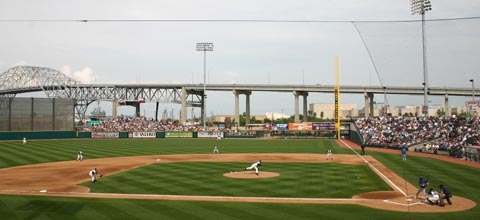 |
If you’ve been to a home game of the Round Rock Express, then you’ll have a strange feeling of deja vu when you walk into Whataburger Field in Corpus Christi, TX. The basic design and even the sound effects between pitches are almost exactly what you’ll encounter at an Express game 240 miles to the north at Round Rock’s Dell Diamond.
| Ballpark Stats |
| First game: April 17, 2005 (the very first pitch is shown in the photo above) |
| Capacity: 5,460 fixed seats, about 2,500 more are permitted for General Admission |
| Price: $27.7 million |
| Home dugout: 3B side |
| Field points: Northeast |
| Playing surface: grass |
| Betcha didn’t know: Park was built on the site of cotton warehouses |
But you’ll quickly come to realize that Whataburger Field has some touches that make it unique when compared to any other park, and in some ways it improves on a couple of aspects of the Dell Diamond.
The main way in which the Corpus Christi Hooks’ new home distinguishes itself is in its setting. Its location near an active shipping channel, which is quite close to Corpus Christi Bay, provides some wonderful views from inside the stadium.
And the excitement surrounding the new park has been huge. The team’s play-by-play broadcaster, Matt Hicks, told me before the season that the “interest here is through the roof.” Added Hooks Assistant GM Michael Wood, “We’ve received tremendous support from everyone, allowing us to exceed our season-ticket goal.” In addition, all 18 of the park’s luxury suites were sold 14 months before a pitch was thrown there.
After all, when Nolan Ryan’s family and his investors are involved, things turn out incredibly well. They are the ones who turned the Jackson (Mississippi) Generals into the ultra-successful Round Rock (Texas) Express. Was there any doubt that his Hooks and Whataburger Field would also be triumphs?
The Setting
As you’ve probably noticed, many new Minor League parks are located downtown. Not usually right in the heart of a business district, but not too far away, often on land that hasn’t been developed commercially to any great extent. That is the case in Corpus Christi, as the park’s location puts it on the opposite side of Highway 181 from the downtown hotels and office buildings, and across the shipping channel from the heavily tourist area that includes Corpus Christi Beach, the Texas State Aquarium and the permanently docked U.S.S. Lexington. While this makes it close to the action, without being right inside it, it does create the opportunity for varied and fantastic views from within the park.
The main attraction of the view, visible from almost every vantage point in the facility, is the massive Harbor Bridge. It towers over right and center field, and provides a good deal of visual interest in the view. It is reminiscent of the spectacular view of the Ben Franklin Bridge from the ballpark in Camden, NJ. The other elements of your view in Corpus Christi depends on where you are sitting. If you’re behind home plate, you can see the U.S.S. Lexington, now used as a museum. Its distinctive lighting is particularly striking at night. If you’re on the third-base side, you’ll probably be able to catch a glimpse of the city’s new arena, which is just a few blocks away. On the first-base side, especially in the upper rows, you can see the shipping channel and some very large vessels. All in all, Whataburger Field has some of the more interesting views in the Minors.
The land on which the stadium was built belonged to the Port of Corpus Christi, and in fact, abandoned cotton warehouses occupied the land until the ballpark came along. Some of these cotton facilities were brilliantly incorportated into the design of the park (see The Design below).
The Exterior
I love it when the architects of a ballpark do three things in creating its exterior look: utilize existing structures in the design; pay homage to the history or architecture of the city; and use light effectively (so the park looks good at night). I’m very pleased to say that HKS, the architectural firm behind Whataburger Field, did a solid job in all three areas.
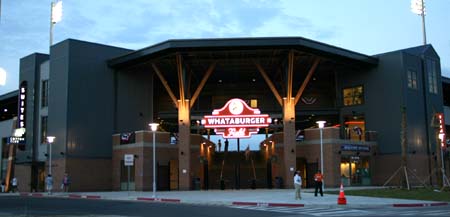 |
First, HKS incorporated existing cotton warehouses into the left-field and right-field areas. While I’ll have more to say about this in The Design section below, this does help give the outside of Whataburger Field a varied and unique look.
Second, since this was an area where the cotton trade ruled decades ago, HKS and the Hooks did several clever things. For one thing, there is a season-ticket-holder lounge in the park called The Cotton Club. For another, the exterior of the main seating bowl alternates bricks and a material that looks a great deal like the cotton warehouses that once stood here — and still do beyond left field. And best of all, the main entryway is superb, in that the high roof and distinctive columns are reminescent of the supports that held up the roofs of those warehouses.
Third, wall-washing lights make the entryway even more striking at night. In fact, the entire exterior of the park is really quite attractive, and reminds me of the spectacular use of lighting on the outside of Philadelphia’s Citizens Bank Park.
The Design
So there is no denying the fact that a great deal of cotton passed through these grounds. The warehouses, some of which housed huge cotton presses, are a very noteworthy feature of Whataburger Field. Beyond right field, there is a picnic area called Kieschnick’s Korner. This covered area is named after area native Brooks Kieschnick (who pitched for the Hooks in the first game ever played in Whataburger Field!), and was constructed using timbers from the old cotton warehouses on the premises. Even better, on the left field side, two structures from the 1920s were left standing. These housed massive presses that were used to compress the cotton into large bails for shipping. While the presses are no longer operational, the large gears and supports are still there. Nice touch! A concession stand and picnic tables sit under these structures. This is site planning at its best.
I’ve already mentioned how impressive the exterior of the main entryway is. Well, it’s great on the inside, too, as you immediately ascend a grand stairway once you’ve come through the gates. This takes you up to the level of the main concourse, which is just behind the last row of the main seating bowl. This concourse is one significant way that HKS improved upon the design of the Dell Diamond (it designed that stadium, too). In Round Rock, the concourse just behind the seats is way too narrow. In Corpus Christi, though, this concourse is much more spacious — even though there are far fewer rows in the grandstands at Whataburger Field.
Speaking of the seating bowl, there are no bleachers. Everything is “theater-style” seating with arms and cup-holders — just like in Round Rock. Even the color of the seats (dark green) matches the Dell Diamond. The comparisons continue: the bullpens are just outside the outfield walls; there is a 360-dgree concourse; the scoreboard, which cost $1 million by itself, is in left field and features a beautiful, high-res color video screen over the standard black-and-white game info (see the photo below showing the scoreboard between two of the cotton buildings left standing); there’s a separate speed-of-pitch board in left field; kids can enjoy an elaborate playground beyond the center-field fence; you’ll find a Sport Court near the playground; plus there’s a rock-climing tower in right center and a swiming pool beyond right field … all of these are features also found in Round Rock in approximately the same locations within the park.
But if it ain’t broke, there’s no need to fix it. All of these features have been huge hits at the Dell Diamond, and there’s no reason to think the fans of Corpus — most of whom haven’t seen a game in Round Rock — wouldn’t love them, too.
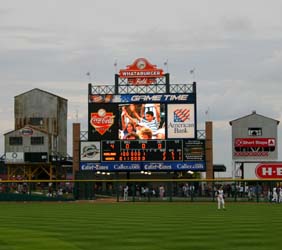 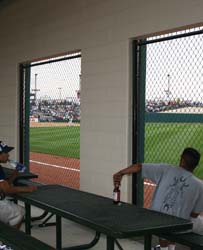 |
There are countless aspects of Whataburger Field that are essentially “nice little features.” One is an area down the first-base line (see photo above) where fans can sit at picnic tables and watch the action through fenced-over openings in the wall — just like the area beyond right field in San Francisco’s SBC Park. Another is the so-called “batter’s eye” in center field. In most stadiums, it is a solid color. The one in Corpus Christi is black — but it’s not made of wood or concrete. Instead, it is a mesh material that allows fans to see through it (somewhat) so the Harbor Bridge is visible. In addition to the Sports Court in center field, there are also “berm” areas in left field and right center. The ground is built up to form a fairly high hill in the latter area, providing fans sitting on blankets there a particularly nice vantage point of the action. Beyond that hill is a ballfield that hosts youth-league games prior to every Hooks night game. While not as elaborate as the Dr. Pepper Youth Ballpark in Arlington, it is within the confines of the stadium, like the ones in Kansas City and San Diego.
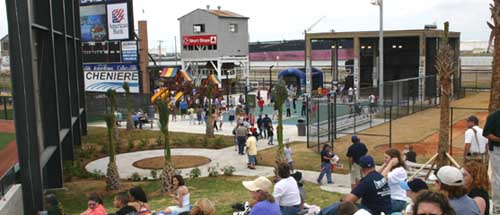 |
The photo above shows the view from the top of the berm “hill” near the center-field fence, looking toward the left-field berm. To the left, you see the batter’s eye. To its right is the playground (somewhat protected from home-run balls by signage) and toward the top of the photo is one of the 80-year-old structures that housed a cotton press. To the right of that is the sport court. Finally, there’s the youth ballfield in the right-hand part of the shot. Yes, there are a lot of nice features in Whataburger Field!
The Essentials
So it has a great design and wonderful views. What are the creature comforts like? Hey, did you think that a ballpark run by Nolan Ryan’s group would have poor food and souvenir options? Of course not.
Regarding food, there is the obligatory Whataburger concession stand in the stadium’s best location: at the top of the entryway stairs, right behind home plate. But Whataburger, which is headquartered in Corpus Christi, coughed up the money to put their name on this stadium for the next 15 years, so I think they’ve earned the right to have a large stand here. And their food isn’t bad, either!
One food stand you won’t want to miss is the Nolan Ryan Grill, featuring Texas-raised beef. In addition, there’s very good BBQ behind first base and grilled items behind home plate. For those of you with a sweet tooth, you’ll find funnel cakes, Dippin’ Dots (you know, the ice cream of the future from 15 years ago) and caramel corn. There’s also a Beers Of The World stand on the first-base concourse. In other words, the food choices are at least as good as at most Triple-A parks … and keep in mind that the Hooks are a Double-A team! The concession prices are quite in line with the rest of the Texas League.
Speaking of prices, parking costs $3 (the same as at San Antonio and at Round Rock when they were a Double-A team) and a very nice program costs only $2. The souvenir shop, which has the adorable name “Hook, Line & Sinker,” is packed with Hooks merchandise, typically priced a little higher than at other Double-A parks.
The most important price of all — tickets — is reasonable for the Texas League. Reserved seats are $9 and general-admission (in other words, to sit on the berm) is $5.
 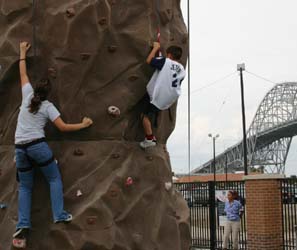 |
A lot of attention was devoted to keeping the kids happy. The Hooks don’t just feature one mascot. No, you’ll find a huge silver hook named Rusty and a seagull named Sammy. The playground in the outfield is first-rate, and for older kids the nearby Sport Court offers the other National Pastime, basketball, plus there’s rock climbing (photo above right).
All in all, the food and entertainment options at Whataburger Field are excellent.
Summary
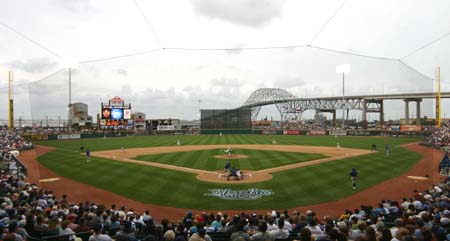 |
It had been 46 years since affiliated baseball had been played in Corpus Christi, so there were plenty of nay-sayers when the concept of a Texas League team playing in a to-be-built stadium was raised in 2002. But when Ryan-Sanders Baseball, the owners of the Round Rock Express, throws its support behind something, you can bank on it being successful. Whataburger Field is exactly that — a success.